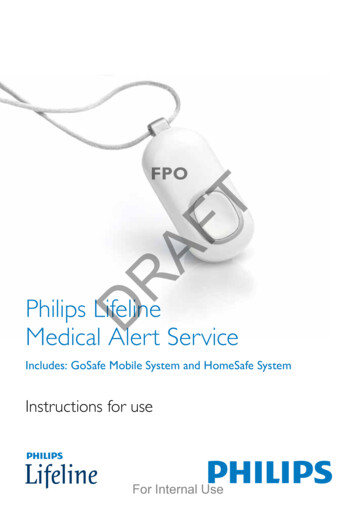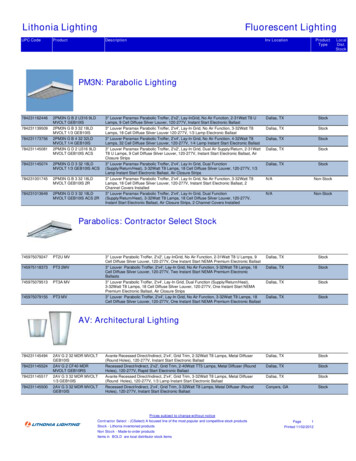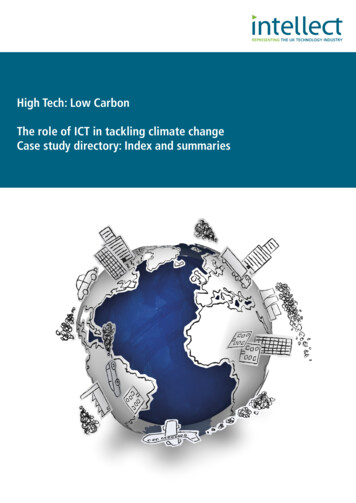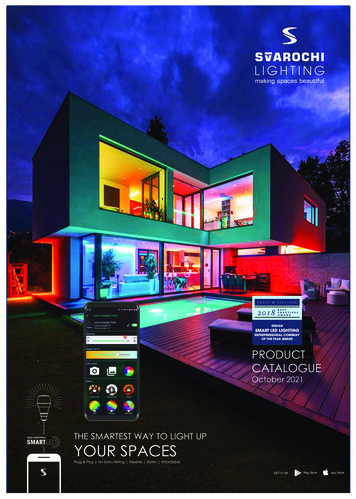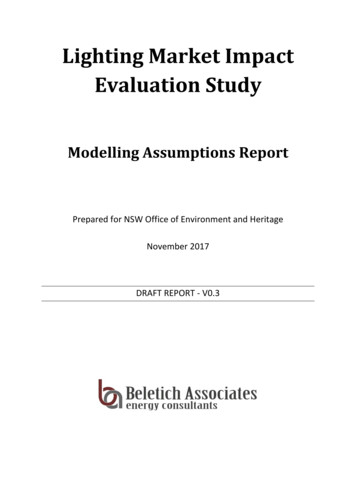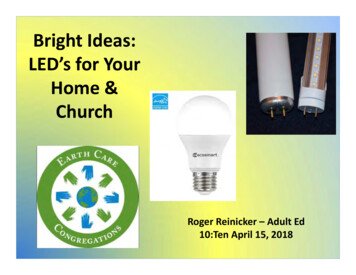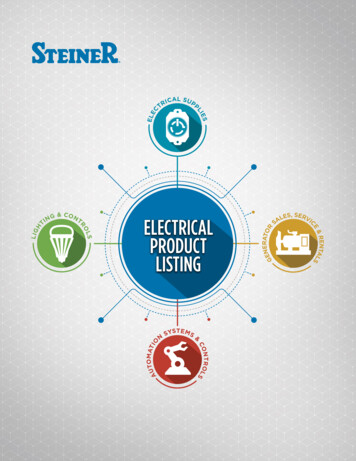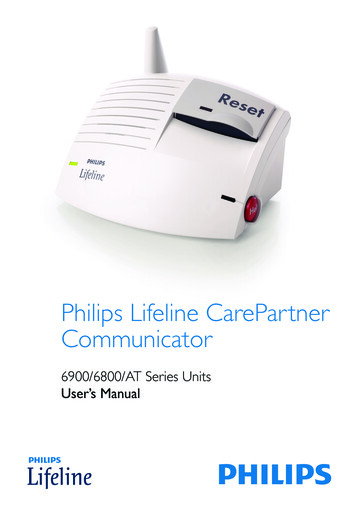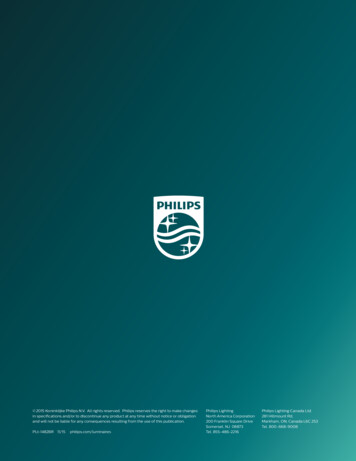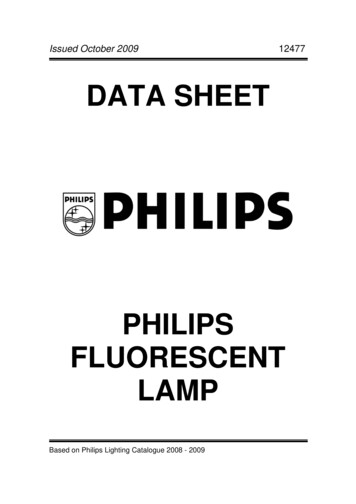
Transcription
Issued October 200912477DATA SHEETPHILIPSFLUORESCENTLAMPBased on Philips Lighting Catalogue 2008 - 2009
12477Technical information LampsColour characteristics of lampsFour categories, as a practical guideline, are:Lamps do not all emit light of the same colour.Colour renderingColour impressionIt is often assumed that once a colour temperatureLight colourColourType of lamptemperatureor lamp colourDaylight6000 K/865Cool white5000 K/850, /950there is, for example, a striking difference between2500 - 2800 K. Warm/cosyhas been chosen, the colour impression isthe pronounced amber light from standard sodiumthe colour from incandescent lamps, thedetermined. this is not the case. the colourlamps, and the white light from most other lamps.fluorescent and compact fluorescent lamps inimpression is not solely determined by the colourEven then, one white light is not the same asthe colours /827 and /927 and the SdW-t Whitetemperature of the light source, but also by theNeutral white4000 K/840, /940, CDM/942,another. to select the proper light source forSon lamp. Generally used for intimate and cosycolour rendering properties.“Crisp”3000 KHalogen Low Voltagetheir colour characteristics, two parameters areenvironments where the emphasis is on a peacefulmoreover, colour temperature and colour renderingwarm whiteimportant: the colour temperature of the emittedrelaxing ambience.are completely separate parameters. cool daylightHPI Plus, MHNHalogen, CDM/830,/930,230 V-HalogenIncandescent, /827/927and incandescent lamps have fully natural colourlight and the colour rendering.“Cosy” warm white2500 KVery warm white2000 KSON PlusCRIType of lamp2800 - 3500 K. Warm/neutralrendering properties. the same is true for halogenColour temperaturethe colour from halogen lamps, colour /830 andlamps. the reason for this is the continuousthe colour of the light has an important influence/930 fluorescent lamps and maStEr colour /830spectrum of the sources.on the colour impres-sion of the area, the colourlamps. used in places where people are active,on the other hand, most gas discharge sourcesColour renderingtemperature of the light source plays an essentialrequiring a welcoming comfortable ambience.have an interrupted or line spectrum. this has anIndoor applicationsSON Comfortor lamp colourinfluence of the quality of their colour renderingrole. Light is popularly termed ‘cool’ or ‘warm’.However, to enable an objective comparison of the3500 - 5000 K. neutral/coolproperties, which varies from very poor (withcolour impressions from various sources, subjectivethe light colour from /840 and /940 fluorescentSoX low-pressure sodium gas discharge lamps) toimpressions such as these are inadequate. a preciselamps as well as maStEr colour /942 and mHnexcellent (with the colour /90 series fluorescentscale is required, and this is given by the termmetal halide lamps. usually applied in commerciallamps and mastercolour /942 lamps).‘correlated colour temperature’;areas and offices where a look of cool efficiency isIn selecting a particular lamp type, a clearthe colour gradation of the light is compared withdesired.understanding of the colour rendering propertiesis essential. a fair indication is given by the colourthe light emitted by an intensely heated iron bar ofwhich the temperature is known.5000 K and above. daylightrendering index (crI), which is a standardizedIn this way, the light colour can be specified by adaylight and cool daylight. the light colour that bestscale with 100 as maximum value. colours are bestvalue in Kelvin (K).matches natural daylight, such as fluorescent coloursshown under a light source with the highest colour/850, /865, /950 and /965.rendering index. Incidentally, it is only worthwhileSDW-T100Incandescent, 230 V-HalogenHalogen Low-VoltageExcellent/927, /930, /940, /950, /96590GoodModerateCDM/942/827, /830, /840, /850, /865,8070CDM /830, SDW-T, MHNHPI Plus, /54SON Comfort60Insufficient/33/3550Poor 40SON Plusto compare crI values of lamps with similar colourtemperature.Based on Philips Lighting Catalogue 2008 - 2009Page 1 of 44
12477Technical information LampsLamp positioning on Tc and CRIProper use of fluorescent lampsIndoor general lightingCRI"functional"yellowishTc 2 400KOptimal solutionEventually suitableWarm whiteNeutral white"cosy"warm white2400 Tc 2800"crisp"warm white2800 Tc 3500"fresh / active"neutral-cool white3500 Tc 5000"daylight"daylightTc 5000K90-100halogen HV Incandescent*/927Halogen LV */930CDM/942 */940*/950, */96580-90*/827 SDW-T*/830*/835, */840*/850, */865Philips light colours798279278309303384094054850950865965*/54CIE Colour rendering group1A1B1A1B1A2B1B1A2A1B1A1B1A70-8060-70SON(-T) Comfort40-60*/29, */35 ML, HPLComfort20-40SON(-T) (Plus) 20SOX(-E)Cool daylightShoplightingHPI(-T) (Plus) */33Sales areasHPL-NGroceriesMeatTextiles, leather* for fluorescent lamps like TL5, TL-D, PL-L, PL-C, PL-T, PL-S, SL. Not all fluorescent lamps are available in all colours mentioned in the table.Furniture, carpetsSports, games, stationeryPhoto, clocks and jewelleryCosmetics, hairdressingIn practice, three categories are normallythis classification is of course dependent upon theFlowersfounddemands that a particular application makes onIndustrya lamp. For example, an ra of 60 is inadequate forWorkshopsshop lighting, but is good for functional road lighting.Textile manufacturecrI between ra 90 and 100Excellent colour rendering properties.BookshopsElektro., mechanical assemblyPrinting, graphical tradesapplications: mainly where correct colour appraisalColour temperature and colour renderingColour testingis a critical task.correct light colours and correct reproduction ofStorescolours assists us in recognising our surroundings.PaintshopsPlant growersOffices, schoolscrI between ra 80 and 90the colour climate of an artificially-lit space isOffice areasGood colour rendering properties.determined by the light colour and the colourConference roomsapplications: in areas where critical colour appraisalrendering.is not the primary consideration but where goodroom furnishings of wood and fabrics in warm orrendition of colours is essential.pastel colours require warm lighting in the colourTeaching areasLobby, corridorOthersDwellingsRestaurants/827 or /927.MuseumscrI below ra 80the more business-like the interior are, the coolerHospital bedroomsmoderate to poor colour rendering properties.the light can be. Furniture using chromium, glass andapplications: in areas where the quality of colourmarble, or in black and white, are emphasised by therendering is of minor importance.cool light colours /840 and /940.Based on Philips Lighting Catalogue 2008 - 2009Sport, multipurpose ereasTreatment roomsPage 2 of 44
12477Technical information LuminairesProtection against electric shockdegrees of protection against external mechanicalProtection against ingress of solid bodies,Ip 20Luminaires are classified as being of insulationimpact (IK code) and the method of testing. thedust and moistureLuminaires which can be applied indoors only if noclass I or II according to how much protection isluminaire housing should withstand the definedthe Ingress protection system (Ip) En 60529, 1991specific pollution rates are expected. offices, dry,provided against accidental touching of live parts.energy of the mechanical shock without losingdefines various degrees of protection against theheated industrial halls, shops, shopping malls andInsulation class I: all metal parts that the userits electrical and mechanical safety, or the basicingress of foreign bodies, dust and moisture. thetheatres are typical application segments.may come into contact with during operation orluminaire function.term ‘foreign bodies’ includes things like fingersservicing are connected to the earth conductor.translated into a more practical implementation,and tools coming into contact with the electricalIp 21/22this means that after withstanding the shock,live parts of the luminaire. Both safety aspectsLuminaires which can be applied in unheatedInsulation class II: additional insulation providesdeformation of the mirror and housing is allowed,(contact with live parts) and harmful effects on the(industrial) halls and under canopies as thedouble protection against high voltage live parts.although broken lamps, an unsafe electrical situationfunction of the luminaire are defined. note thatluminaires are drip-and condensation-water-and failure to meet the specified Ip classificationsthe conditions during testing might differ from theprotected.Protection against mechanical shockare not permitted.specific conditions in an application. the designationthe impact resistance of a luminaire defines thethe impact resistance is expressed as a groupto indicate the degree of protection consists ofIp 23protection of the luminaire against mechanicalnumeral, for instance IK06, which is related to thethe characteristic letters Ip followed by 2 digitsLuminaires which can be applied in unheatedshock. the European norm En 50102 defines theimpact energy in joule.indicating conformity with the conditions stated inindustrial halls or outdoors.all types of luminaires of philips Lighting have athe two tables. all philips Lighting luminaires fulfilminimum impact resistance of 0.2 J. the table showsthe minimum classification: Ip 20 (protected againstIp 43/44the ten IK classifications and the defined shockfinger contact with live parts), however a selectionLuminaires and bollards for outdoor street lightingenergy in joule.of luminaires, especially those for industrialand street lanterns. Bollards mounted at a lowProtection against electrical shockSafetySymbolProtectionclass0Basic insulation only (not recommended)IBasic insulation plus protective earthconnectorIIDouble or reinforced insulation, no provision for protective earthingIIIapplications, meet a higher Ip classification. It isheight are protected against small solid objects andnote that vandal-proof Iuminaires are not available:important to realise that the specification and safetyagainst rain and splash.vandal-protected and vandal-resistant are the bestof luminaires are only secured if the necessarya common combination within an industrial high-achievable classifications.maintenance according to the instructions of thebay luminaire or street lantern is Ip 43 for themanufacturer is carried out in time. the mostelectrical part of the luminaire, to secure safety, andcommon applications of the Ip classifications forIp 54/65, for the optical part of the Iuminaire, toluminaires are:prevent pollution of reflector and lamp.Supply of safety extra-low voltageProtection against mechanical shockIK codeShock energy (Joule)IK00–IK010.15DescriptionExampleIp 50Luminaires which are applied in dusty environments,IK020.2IK030.3StandardStandard open luminaire, closed luminaire with acrylic coverIK040.5Standard plusOpen luminaire with reinforced optical ctedClosed luminaire with polycarbonate or hardened glass coverIK0910IK1020Vandal-resistantClosedto prevent rapid pollution of the luminaire.the exterior of Ip 50 luminaires can be cleanedeasily. In the food industry, closed luminaires arespecified to prevent glass particles from accidentallyBased on Philips Lighting Catalogue 2008 - 2009broken lamps entering the production area andcontaminating the products under preparation.Page 3 of 44
12477Technical information LuminairesIp 54the traditional water-protected classification.Luminaires can be cleaned with water without anyharmful effect. this classification is often specified inthe food processing industry, for industries whereProtection against ingress of dust, solid objects and moistureFirst number:Second number:Degree of protection against accidential contact/contact Degree of protection against ingress of moisturewith external elementsFirst numberSecond 0Non-protectedNot protected0Non-protectedNot protected against moisture1Hand-protectedProtected against solid objectsexceeding 50 mm in diameter1Drip-proof against verti- Water drips falling vertically shall have nocal water dropsharmful effect2Finger-protectedProtected against finger contactwith live parts and solid objectsexceeding 12 mm in diameter2Drip-proof when tiltedat angles up to 15 Water drips shall have no harmful effect3Tool-protectedProtected against contact with liveparts by tools, wire or similar objects over 2.5 mm and penetrationof solid objects exceeding 2.5 mm3Rain-/spray-proofWater falling at an angle of up to 60 shallhave no harmful effect4Wire-protectedProtected against contact withlive parts by tools, wire or similarobjects over 1 mm thick; and penetration of solid objects exceeding1 mm in diameter4Splash-proofSplashing water from any direction shall haveno harmful effect5Dust-accumulationprotectedComplete protection against5contact with live parts and harmfulaccumulation of dust; some dustmay enter but not to the extentthat operation is impairedJet-proofWater projected by a nozzle from anydirection shall have no harmful effect. (Nozzlediameter 6.3 mm, pressure 30 kPa)6Dust-penetrationprotectedComplete protection againstcontact with live parts and againstpenetration of dust6Jet-proofWater projected by a nozzle from anydirection shall have no harmful effect. (Nozzlediameter 12.5 mm, pressure 100 kPa)7WatertightWatertight; temporary immersion in waterunder specified conditions of pressure andtime possible without ingress of water inharmful quantities8Pressure watertightPressure watertight; continuous submersion inwater under specified conditions of pressureand time without ingress of water in harmfulquantitiesdust and moisture are generated in the hall, and foruse under canopies.Ip 60Luminaires which are completely sealed againstdust accumulation, and are used in very dustyenvironments (wood and textile industry, stonecarving) and in the food industry as explainedabove. Ip 60 luminaires are rarely applied; Ip 65/Ip66 is usually applied instead.Ip 65/66Jet-proof Iuminaires which are applicable where thesurroundings are hosed down frequently by waterjets, or where luminaires are applied in a dustyenvironment. although the luminaires are not fullywatertight, the potential ingress of moisture will nothave any harmful effect on the luminaire function.Ip 65/66 luminaires are often available in impactprotected versions.Ip 67/68Luminaires complying with this classification aresuitable for immersion in water. typical applicationareas are underwater lighting of swimming poolsand fountain Iighting. deck lighting on ships shouldalso meet this classification. the test method doesnot imply that Ip 67/68 Iuminaires meet the Ip65/66 classifications as well.Based on Philips Lighting Catalogue 2008 - 2009Page 4 of 44
12477Most used light-technical termsAverage illuminanceColour renderingDirect lightingHalogen HVIlluminance averages over a specified surface.the ability of a light source to render coloursLighting by means of luminaires with a light distribu-High-voltage (230 v) halogen lamp.unit: lux (lx) lm/m2naturally, without distorting the hues seen undertion such that 90 – 100% of the emitted luminousSymbol: Eava black full spectrum radiator (like daylight orflux reaches the working plane directly, assumingHalogen LVincandescent lamps). the colour-rendering indexthat this plane is unbounded.Low (safety) voltage (6 v, 12 v or 24 v) halogen lamp.BallastcrI ranges from 0 to 100. For further details seedevice used with discharge lamps for stabilising the‘Specification data lamps’.current in the discharge.operating low voltage halogen lamps requires anDisability glareelectronic or electromagnetic transformer, which isGlare that impairs vision.often integrated in the specific luminaire.Discomfort glareHFDGlare that causes discomfort without necessarilyElectronic dimmable ballast by which dimming isimpairing vision.possible. Ballast functions according to the daLIColour rendering index CRIBeam spreadSee colour rendering.the angle in the plane through the beam axis overwhich the luminous intensity drops to a statedColour temperaturepercentage (e.g. 50%) of its peak intensity.the temperature in kelvin of a full spectrumprotocol.radiator most closely approximate to the colourDust-proof luminaireBrightnessappearance of a light source at the same brightness.Luminaire constructed so that dust of specifiedHFPattribute of visual sensation according to which anFor further details of philips lamps see under-nature and fineness cannot enter it when it is usedElectronic ballast for various fluorescent lamp typesarea appears to emit more or less light. Brightness‘Specification data lamps’.in- a dust-laden atmosphere.with warm-start principle. See also ‘Specificationof colour. In British recommendations the termDALIGlare“Brightness” is now reserved for descriptions ofdigital addressable Lighting Interface, a standardisedSee disability glare and discomfort glare, and theHFR-Tcolour. Luminosity should be used in othercommunication interface to regulate lighting levelschapter ‘Information - Lighting technique’.Electronic ballast for tL5 and tL-d lamps. With thisinstances.and to switch electronic HFd ballasts on and off.data luminaires’.according to the definition is also an attributenew-style electronic ballast, standard buttons canHalogen lampbe used to dim the light output to as little as 3%.CandelaDaylight linkingIncandescent lamp in which the inclusion ofthe lamp can also be switched on or off using thethe standard unit of light intensity, abbreviated asnatural light is energy saving and beneficial tohalogens in the gas filling and a high-temperaturepush-button control.“cd”, being one lumen per steradian.individual users. daylight linking is a techniquequartz envelope promote the tungsten halogenthat regulates light output according to daylightcycle, permitting higher filament temperature.HFRColour changeconditions, maintaining a constant level of indoorthe result is a higher colour temperature and aElectronic ballast for various fluorescent lamp typesthe ability to change the colour temperature oflighting and ensuring comfort at all times.significantly extended life. Halogen lamps are oftenby which lighting regulation is possible. the mainapplied to create sparkling lighting effects.ranges of HF-r ballast allow step-less dimminga lighting installation makes it possible to createeither a more comfortable working environment ordown to 3%. See also ‘Specification data luminaires’.introduce dynamic lighting effects.Based on Philips Lighting Catalogue 2008 - 2009Page 5 of 44
12477Most used light-technical termsHPI PlusLight output ratio (L.O.R.)Luminous fluxIt is one of the main specification elements formetal-halide high-intensity discharge lampthe ratio of the total light emitted by a luminaire tothe total light output emitted by a light source. alsothe lighting designer. In the various norms, thecombining high luminous efficacy with whitethe total light out-put of the lamp(s) it contains. thethe total light falling on a surface. Light output of amaintained illuminance is specified for variouslight of moderate colour rendering. main indoorlight output ratio is always less than 1.light source is measured in lumen.activities.unit: lumenunit: luxSymbol:Symbol: EmLuminous intensityMaintenance factorthe luminous flux in a given direction (e.g. from acorrection factor used in lighting design toapplications are big industrial halls and lighting ofdiscount stores, hyper-/ supermarkets and dIyLumen depreciationshops. Indoors, HpI plus lamps are applied in high-decline of light output of a light source during itsbay , projector).compensate for the rate of lumen depreciation,the luminous flux density at the surface being lit.Equipment that distributes, filters or transforms theunit: candela (cd) one lumen per steradiancaused by lamp ageing (lumen depreciation andthe unit is lux, being one lumen per square metre.light given by a lamp or lamps, and which containsSymbol: Ilamp failures) and dirt accumulation (luminaire andthe illuminance in the full summer sun is approx.all the necessary items for fixing and protecting the100000 lux. recommended illuminances for worklamps and connecting them to a power supply.environment). It determines the maintenance cycleLuxneeded to ensure that illuminance does not fallplaces range from 200 lux for rough work to 2000the standard unit of illuminance of a surface beingbelow the maintained value.lux for detailed critical work.lit. one lux is one lumen per square metre.unit: lux (lx) lm/m2LuminanceSymbol: Ethe light intensity per square metre of apparentMaintained emergency lightingSeries of metal-halide discharge lamps witharea of the light source, luminaire or illuminatedEmergency lighting where the lamps are inexcellent colour rendering and a warm or neutralIndirect lightingsurface (cd/m2). Where surfaces are lit, theoperation from the normal supply during standardcolour impression. maStEr colour lamps areLighting by means of luminaires with a lightluminance is dependent upon both the lighting levelconditions. In an emergency situation theapplied in projectors and downlights in shop anddistribution such that not more than 10 per centand the reflection characteristics of the surfaceemergency lamp (usually one lamp in luminaires ofoffice applications.of the emitted luminous flux reaches the workingitself.two or more lamps) remains in operation.plane directly, assuming that this plane is unbounded.unit: cd/m2Symbol: LInduction lighting QLMASTER Colour CDMMercury lampsMaintained illuminanceHigh-intensity discharge lamps for use in industryvalue below which the average illuminance onand large public spaces. Better light characteristicsare obtained by applying metal-halide lamps.Electrode-less induction lighting systemLuminous efficacythe specified surface is not allowed to fall. thecharacterised by good light quality, high luminousthe quantity of light a light source emits per wattmaintained illuminance is specified at the end of theefficacy and a phenomenal life (60000 hours).of electrical power of energy consumed. note thatmaintenance cycle, taking into consideration theMetal-halide lampsboth the lamp luminous efficacy and the systemmaintenance factor.Single- or double-ended discharge lamps for use inJet-proof luminaires(lamp and ballast) luminous efficacy can be specified.industry, public spaces and shops. metal-halide lampsLuminaire constructed to withstand a direct jet ofthe system luminous efficacy is always lower thancombine a natural white colour with a pleasant lightwater from any direction.the lamp luminous efficacy.and a high luminous intensity.Based on Philips Lighting Catalogue 2008 - 2009Page 6 of 44
12477Most used light-technical termsMovement detectionQLTL-Dto control lighting in a specific area, sensing ofSee Induction lighting.Linear standard double-ended fluorescent lamp witha diameter of 26 mm.occupancy by movement detection ensures lightsare activated only when needed.SDW-TWhite Son or SdW-t lamps offer a high luminousUniformity ratioNon-maintained emergency lightingefficacy in combination with a warm white light.the ratio between the minimum and the averageEmergency lighting where the emergency lightingthe colour rendering is excellent. SdW-t lampsilluminance over an area (Emin/Eave). If so defined, thelamps come into operation only when the powerare applied in shops and public spaces where theuniformity ratio is the ratio between the minimumsupply to normal lighting fails.atmosphere should be warm and cosy.and the maximum illuminance over a specifiedOLCSodium lamps SONomnidirectional Luminance control, a philips-High-pressure discharge lamps with a yellowishUtilisation Factorpatented series of optics for tL5 and tL-d lampscolour appearance and an extremely high efficiency.the utilisation Factor (uF) of a lighting installationoffering optimal lighting efficiency in combinationSon and Son comfort lamps are mainly applied inrepresents the percentage of the luminous flux ofwith excellent glare and luminance control allhigh-bay industrial applications.the lamp(s), that reaches the defined working plane.surface (Emin/Emax).around the luminaire.the uF can be seen as the efficiency of the lightingStarterinstallation. the uF is used to calculate the numberPLdevice for starting a discharge lamp (in particularof luminaires required.Single-ended fluorescent lamp in which thea fluorescent lamp) that provides the necessarydischarge tube is folded to two, four or six limbs.preheating of the electrodes and/or causes a voltageVisual guidancepL lamps are characterised by unusually high lightsurge in combination with the series ballast.the sum of the measures taken to give the user of aoutput for length. pL lamps are to be applied inspace an unambiguous and immediately recognisablecompact luminaires for professional and domesticSwitching and dimming controlpicture of the course of the path ahead.visualuse.as more and more light sources can beguidance is important in shops and public buildings.economically dimmed, lighting controls need tothe lighting designer takes the demands for visualprovide both switching and dimming capabilities.guidance into consideration.Power factorthe ratio of the circuit power in watts to theproduct of the root-mean-square values of voltageTL5and current. For sinusoidal waveforms, it is equal toLinear double-ended fluorescent lamp with athe cosine of the angle of phase difference betweendiameter of only 16 mm. In combination with oLcvoltage and current. For electronic ballasts theoptics and high-frequency ballasts, the tL5 systempower factor is 0.95; no extra compensation isoffers a superb performance, both light-technicallyrequired.and in terms of energy consumption.Based on Philips Lighting Catalogue 2008 - 2009Page 7 of 44
12477Compact Fluorescent Integrated LampsBased on Philips Lighting Catalogue 2008 - 2009Page 8 of 44
12477EssentialEconomyDimensions in mmDCDFCFmax.max.Essential 8W14044Essential 11W15544Essential 14W17044Essential 18W16552Essential 23W17552ApplicationsEssential 8W-14W the Essential range is widely used to replace incandescentlight Enclosed luminaires are required for outdoor use not suitable for dimmers, electronic switches or remotecontrolsEssential 18W6Attractive valueEssential 18W-23WYEARS*Good value for money trusted quality energy savers for best performance choice of light coloursPreferred selection new lamp cap design for a refined, more sophisticatedappearance with embossed philips markingProduct ID LampCap/ Lamp(W)Up to 80% energy saving the Essential range can replace the full incandescent rangefrom 40W up to 125W up to 80% energy savingLong Life: 6 years Long reliable life of up to 6000 hrs, which is 6 times longerwhen compared to standard incandescent lamps 1 year guarantee Safety fuse for flicker free startBest environmental choice the Essential range is fully roHS compliant, conforming tothe most strict environmental legislation in the worldBased on Philips Lighting Catalogue 2008 - 2009Frequency ColourWattage Base Voltage(V)(Hz)Luminous Luminous ColourEquivalentBoxTemperature FluxEfficacyRendering light uantity Code8710163Cool DaylightEssential8WE27220-240V 50-60Hz6500440558040W12Essential8WB22220-240V WE27220-240V 240V 240V 240V 240V 0-240V 0-240V 0-240V 50-60Hz650014206280125W1239609515Warm WhiteEssential8WE27220-240V 40V 240V 240V 240V 240V 240V 0-240V 0-240V 0-240V 50-60Hz270014606382125W1239608815Page 9 of 44
12477Essential 12V Direct CurrentEconomyDDDimensions in mmCFEssential DC6W12544Essential DC11W15544CApplications the Essential 12v dc is perfectly suitable in applicationswith low voltage power supply like busses, ships and cars andin combination with solar panelsFEssential 12VEssential 12V6YEARS*A perfect light inremote areasPerfect suitable for remote areas the lamps operate on a simple 6-13v battery, enabling youto have light also in remote rural areas with limited powersupply the Essential 12v dc can be directly used in combinationwith solar panelsUp to 80% energy saving the Essential 12v dc lamps offer you the additional benefitof up to 80% less energy consumption when compared tostandard incandescent lampsPreferred selectionProduct IDCap/LampWattage BaseVoltage(W)(V)Frequency ColourTemp.Lumen Luminous ColourBoxIncandescent Order CodeOutput EfficacyRendering quantity Equivalent(Lm)(Ra)IndexLong Life: 6 Years Long and reliable life of 6000 hrs, which is up to 6 timeslonger when compared to incandescent lampsLamp(Hz)(Lm/W)8710163Cool DaylightEssential al al ial DC11WB2210-13V50-60Hz65005805280660W21044510Warm WhiteBased on Philips Lighting Catalogue 2008 - 2009Essential al al DC11WE2710-13V50-60Hz2700600548
the exterior of Ip 50 luminaires can be cleaned easily. In the food industry, closed luminaires are broken lamps entering the production area and contaminating the products under preparation. 12477 Based on Philips Lig
